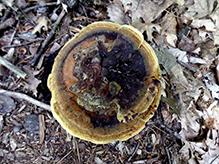Dyer’s Polypore
(Phaeolus schweinitzii)
Conservation • Description • Habitat • Ecology • Distribution • Taxonomy
Conservation Status |
|
|||||||
| IUCN Red List | not listed |
|||||||
| NatureServe | NNR - Unranked |
|||||||
| Minnesota | not listed |
|||||||
Description |
||
Dyer’s Polypore is native to Europe, Japan, and North and Central America, and is also found in South Africa, Australia, and New Zealand. In these areas it is common wherever there are coniferous forests. It is one of the most common large polypores. It is used to prepare fabric dyes of various colors. It is a significant pest to the timber industry in western United States. In Minnesota it is most common on white pine. The fruiting body is a large, bracket-shaped polypore (conk). It usually appears as a rosette or an overlapping tier of brackets from a common base, but sometimes as a single bracket. It is found in late summer and fall, usually on the ground at or near the base of a large coniferous tree. When it appears to be growing on the ground it is actually attached to roots. It sometimes appears as shelf-like brackets attached to the base of the tree. It is both saprobic, getting its nutrients from dead wood, and parasitic, attacking the living roots and the heartwood of the tree. On older trees, it causes the disease called red-brown butt rot. The lower 10 to 20 feet of the trunk, the most valuable part for the timber industry, is weakened or hollowed, making the tree susceptible to falling over. On young trees the fungus causes root rot which is also fatal. The cap is 2″ to 12″ wide. When growing on the ground it is usually circular, when on a trunk it is usually semicircular or fan-shaped. When young it is soft, spongy, often knobby, light brownish-yellow to orange or reddish-brown, yellow or greenish-yellow at the margin, and densely covered with velvety hairs. As it ages it becomes hard, less hairy, and turns dark brown or rusty brown from the center outwards. The upper surface is dry and flat or somewhat depressed. Older specimens are brittle and dark brown or black, looking something like a cow pie. The flesh is yellowish-brown when young, darkening with age. It is probably poisonous. The stalk, when present, is 1″ to 2″ long, ¾″ to 1″ thick, tapered, velvety below the pore surface, and the same color as the cap. The pore surface is on the underside of the cap and runs down the stalk. It is greenish-yellow to yellow or orange when young, soon becoming brown as it ages. The pores are small, 1 to 3 pores per millimeter, and deep, 1 ⁄16″ to ⅜″ (2 to 10 mm) long. They often fuse together forming larger, angular pores. The spore print is white or yellowish. |
||
Similar Species |
||
Habitat and Hosts |
||
Coniferous trees |
||
Ecology |
||
Season |
||
Late summer and fall |
||
Distribution |
||||
|
Sources |
|||
| 11/18/2022 | ||||
Occurrence |
||||
Common and widespread |
||||
Taxonomy |
|||
| Kingdom | Fungi (Fungi) | ||
| Subkingdom | Dikarya | ||
| Phylum | Basidiomycota (Basidiomycete Fungi) | ||
| Subphylum | Agaricomycotina (Higher Basidiomycetes) | ||
| Class | Agaricomycetes (Mushrooms, Bracket Fungi, Puffballs, and Allies) | ||
| Subclass | incertae sedis (uncertain placement) | ||
| Order | Polyporales (shelf fungi) | ||
| Family | Phaeolaceae | ||
| Genus | Phaeolus | ||
The genus Phaeolus was formerly placed in the family Polyporaceae. That family was split in 1981, and the number of genera and their arrangement into families has been in flux ever since. Mycologists place the genera Phaeolus in the family Polyporaceae, Fomitopsidaceae, Laetiporaceae, or Phaeolaceae. Even the two most respected sources disagree. Index Fungorum places Phaeolus in the family Laetiporaceae, MycoBank in the family Phaeolaceae. |
|||
Synonyms |
|||
Phaeolus spadiceus Polyporus schweinitzii |
|||
Common Names |
|||
Cow-pie Fungus Dyer’s Mazegill Dyer’s Polypore Pine Dye Polypore Velvet-top Fungus |
|||
Glossary
Conk
A shelf-like, bracket-shaped fruiting body of certain fungi.
Saprobic
A term often used for saprotrophic fungi. Referring to fungi that obtain their nutrients from decayed organic matter.
Visitor Photos |
|||||
Share your photo of this fungus. |
|||||
| This button not working for you? Simply email us at info@MinnesotaSeasons.com. Attach one or more photos and, if you like, a caption. |
|||||
Luciearl |
|||||
Looks like stacked half baked cookies |
|||||
 |
 |
||||
This is the same Dyer's polypore taken less than a week later than previous photo sent. It grows and changes appearance quickly. |
 |
||||
MinnesotaSeasons.com Photos |
|||||
|
|||||

Slideshows |
||

Visitor Videos |
|||
Share your video of this mammal. |
|||
| This button not working for you? Simply email us at info@MinnesotaSeasons.com. Attach a video, a YouTube link, or a cloud storage link. |
|||
Other Videos |
|||
| Dyer's Mazegill (Phaeolus schweinitzii), I presume? Clare Blencowe |
|||
About
Published on Jul 16, 2017 |
|||
| Phaeolus schweinitzii (Dyer's polypore) Andrew Kunik |
|||
About
Published on Aug 29, 2017 Found in south west Florida |
|||


Created: 7/26/2019
Last Updated:


